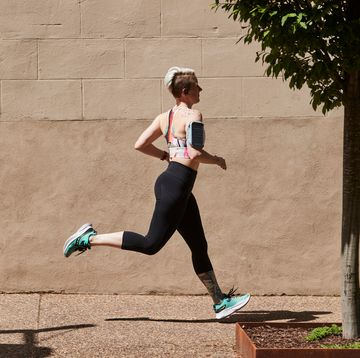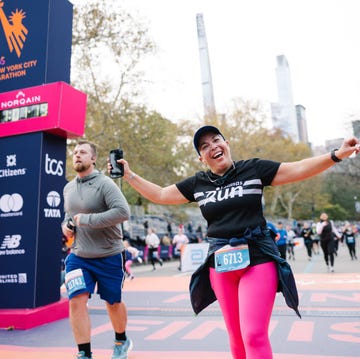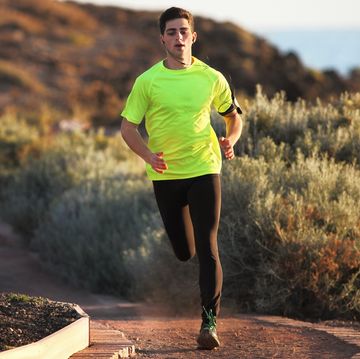As scientific expressions go, running economy (RE) has never been bandied about by runners as much as terms like VO2 max, lactate threshold (LT) and fast-twitch/slow-twitch. Even among exercise scientists, the concept has arguably been neglected, leading Carl Foster and Alejandro Lucia to title a 2007 review article "Running economy: the forgotten factor in elite performance."
The days of running economy's obscurity may be numbered, however. The rise of the minimalist running movement has, among its many other effects, stimulated new interest in and research about running economy. Do shoes make it worse? How about rearfoot striking? Answers from physiology and biomechanics labs are starting to emerge.
Of course, we should begin by defining RE and explaining how it is measured.
RE is analogous to the fuel economy of a car, which tells you how many miles are covered per gallon of gasoline used. In running, carbohydrates and fat are the primary fuels, and complete breakdown of each requires oxygen (O2). The energy needed to run at a given pace thus corresponds to the volume (V) of O2 consumed per unit time, or VO2 (sometimes annotated with a dot above the V to indicate that it's a rate rather than a volume, spawning the technically accurate but cumbersome pronunciation of "V-dot-O-2"). It's measured by comparing the oxygen levels of inhaled and exhaled air, usually during a treadmill test.
Since VO2 depends on body size—larger runners need more oxygen—it's generally normalized to body mass in kilograms and so is reported as milliliters of O2 per minute per kilogram of body mass: (mL/min)/kg. The lower this number is, the better the RE.
Many exercise scientists consider RE to be one of three critical determinants of distance running performance, the other two keys being VO2 max and lactate threshold. In short, VO2 max is your upper limit of oxygen consumption, lactate threshold is the fraction of VO2 max that you can sustain for a long time, and RE is your effectiveness at converting that oxygen consumption into forward motion. While acceptance of this three-part model isn't universal, the importance of RE seems undeniable.
For any given pace, the less energy and oxygen you use, the better.
So what factors can affect an individual's RE? There are many possibilities, starting with one's DNA and anatomy.
MUSCLE FIBER COMPOSITION
Myosin is the protein that powers contraction in muscle cells by pulling on and sliding past actin. Relative expression of type-I ("slow-twitch") and type-II ("fast-twitch") myosin is believed to be genetically determined because it changes little over time even when training is drastically altered. Edward Coyle's lab at the University of Texas has shown that cyclists with more type-I myosin tend to use less oxygen to maintain a given power output. While the data for running are less clear-cut due to the more complex biomechanics, it's reasonable to speculate that RE also reflects one's muscle fiber makeup.
BODY SHAPE
A small body size seems to help RE; even though VO2 measurements are corrected for body mass (see above), smaller runners tend to use less oxygen per kilogram of body mass. Also, according to the physics of rotating limbs, mass toward the bottom of the leg requires more energy to move than mass close to the trunk. Elite East African runners tend to be unusually economical, and it's been suggested that their small overall size and skinny lower legs are partly responsible for this. A 2006 report by Lucia and co-workers at the University of Madrid, for example, indicated that elite runners from Eritrea (the home country of Meb Keflezighi) had REs about 12 percent better than a comparable group of Spanish runners.
SHOES
An extension of the previous point is that shoes add weight at the most energetically costly location of all. Two studies published earlier this year in Medicine & Science in Sports & Exercise provide interesting analyses of this issue.
In the first study, Dan Lieberman's lab at Harvard University measured running economy in experienced barefoot/minimalist runners who were comfortable with both forefoot and rear-foot landings. On average, these runners were 2 to 3 percent more economical in minimalist shoes (Vibram FiveFingers) than in standard shoes (the ASICS GEL-Cumulus 10), irrespective of foot strike position. In the second study, Rodger Kram's lab at the University of Colorado compared RE in midfoot strikers when barefoot and when wearing minimalist shoes (the Nike Mayfly). There was a trend toward better RE in the latter condition, though this didn't reach statistical significance.
The Lieberman study suggests that bare or minimally shod feet can recycle the energy of ground impact more effectively than heavily shod feet, perhaps due to increased freedom of motion in the arch. The Kram study suggests that, in terms of RE, lightweight shoes are worth the extra weight by providing cushioning that, in the absence of shoes, would be an additional energetic burden on the leg muscles. FLEXIBILITY
Among reasonably fit, healthy runners and walkers showing typical variations in flexibility (range of motion resulting from the compliance of muscles and tendons) at the hip, knee and ankle joints, it appears that the less flexible ones are more economical on average. This trend has been explained as a possible consequence of two factors: Stiff joints need less muscle force (and thus less energy use) to stabilize them, and stiff muscle-tendon units provide superior elastic storage and return of energy from a foot's landing to its push-off. It's possible that, for distance runners, moderate flexibility is preferable to very low flexibility (which increases the incidence of injury due to limited range of motion) or very high flexibility (which seems to worsen RE).
RUNNING FORM
Nearly everyone agrees that running form impacts RE, but determining the aspects of form that matter most is surprisingly difficult (see "Running Form & Running Economy").
RUNNING TERRAIN AND AIR RESISTANCE
Just as your car's fuel economy depends on driving conditions, your RE is variable. An uphill slope or difficult footing (such as sand, mud, or unmown grass) raises the metabolic cost of maintaining a given pace, for example. While this is obvious to most people, the same is also true of fighting air resistance on your own rather than drafting behind others. Classic studies from the early 1970s by L.G.C.E. Pugh (a British physiologist with lots of middle names) established that the energy used to overcome air resistance is roughly proportional to the square of the effective wind velocity. The practical significance of this nonlinear relationship, according to calculations made by C.T.M. Davies (another long-named Brit), is that air resistance has a negligible effect on RE at slow paces in calm air. However, a runner churning out 5:20 miles will expend about 2 percent of his energy countering air resistance even in perfect weather.
RUNNING SPEED AND DURATION
RE doesn't vary greatly with running speed, yet experienced runners may notice that certain paces feel especially smooth and natural. These are likely to be the paces at which RE is best. On the flip side, fatigue during a hard workout or race can cause form and RE to deteriorate.
With RE affected by so many variables, it's unsurprising that it can vary considerably from person to person—even among sub-29:00 10K runners like the Africans and Spaniards mentioned above. But given this multitude of variables, are there any strategies for enhancing RE that will work for most people?
Clearly, some of the above factors are changed more easily than others. You can't do much about your myosin composition, but you can decrease air resistance by dressing aerodynamically and running behind your rivals. Possible changes in form can be explored with a knowledgeable coach or biomechanics specialist (see "Running Form & Running Economy"). And if you remember that fatigue can cause form to unravel, dragging RE down with it, monitoring your late-race form may be useful in minimizing such changes.
But what about RE-boosting workouts? Despite the usual limitations of published data, most physiologists and coaches seem to agree on a few points (see "Workouts to Boost Running Economy"). First, the more you run, the more economical you tend to get—so keep running! Second, RE can be somewhat pace-specific, so training at race paces should help your RE at those paces. Third, as summarized by Daniel McCann and Brian Higginson, a few studies have shown improvement in RE from fast intervals near a velocity that elicits VO2 max (vVO2 max)—i.e., a pace that most people can sustain for a maximum of 1-2 miles. Fourth, a 2008 review article by Linda Yamamoto and colleagues indicates a trend toward improved RE when plyometric exercises are added to an endurance training program. This latter effect has been seen both in moderately trained male runners (with 5K times of ~18:15) and more elite runners (with 3K times of ~8:30).
Other tactics have appeared to improve RE in some groups of subjects but aren't as well validated on the whole. These include traditional high-resistance strength training and exposure to hypoxia (by spending time either at high altitude or in a hypoxic chamber).
Assuming that you take a stab at bolstering your RE, how can you tell if you're making progress? The gold standard would be to return periodically to an exercise testing lab and see whether your oxygen consumption at a given pace decreases over time. In the likely case that isn't possible, you can take heart rate as an approximate indicator of energy expenditure and oxygen use. If a pace that used to drive your heart rate up to 140 now brings it to 135, your RE may well have improved. To minimize random day-to-day fluctuations in heart rate, you should do all of your trials under near-identical conditions—for example, on the same treadmill set to the same speed and incline, after the same number of recovery days following your last hard workout. (These experiments can be done outdoors, too, but variations in weather will add additional noise to your heart rate data.) Simply feeling more comfortable than before at a given pace is another sign of possible improvement in RE, but is more subjective and thus less reliable than tracking HR changes.
As reported by Christopher McDougall in Born to Run, Matt Carpenter used a treadmill and heart rate monitor to optimize his RE in preparation for the 2005 Leadville 100-miler. Wanting to know which method of holding water bottles was most economical, he measured his heart rate for different bottle positions, finding that tucking it between his arm and ribs yielded a slightly lower heart rate than carrying it in his hand. Though this insight wasn't Carpenter's biggest advantage over the competition at Leadville—his VO2 max has been measured at 92 ml O2 per minute per kg body mass, perhaps the highest ever recorded in a runner—it didn't hurt, and he won the race by more than 3 hours in 15:42, still the course record.
Finally, it's worth noting that workouts focused on improving RE shouldn't generally drive you to a point of deteriorating biomechanics. If the desired speed and form can be maintained throughout the workout, your body should develop economical habits rather than getting extra practice in unraveling. Because RE-specific workouts don't need to be long or exhausting, they're relatively easy and safe to integrate into a training week. Williams College coach Peter Farwell, an advocate of optimizing RE with drills and short, relaxed bursts of speed, says that especially for those who haven't previously prioritized RE, "At some point, more mileage or harder workouts are not the answer to the next step of improvement." Running Form & Running Economy
Researchers have been trying to define the biomechanical ingredients of economical running form for more than 30 years, and a 2008 review article by McCann and Higginson listed 15 biomechanical variables that correlated with RE in at least one study. Several of these seem logical enough; for example, too much arm movement or vertical oscillation of the center of mass is bad for RE, and bending the knees during the swing phase of the stride is good because it keeps the mass of the leg closer to the trunk.
Yet these factors don't individually or collectively account for most of the variation in RE among runners. Keith Williams, who with Peter Cavanagh performed many of the pioneering studies cited by McCann and Higginson, concluded with apparent frustration in a 2007 Sports Medicine review that "There [do] not appear to be easily identifiable and universally applicable patterns of 'efficient' movement that will apply to all runners.
"Relatively well-studied aspects of form include foot strike position and stride length. Despite some barefoot running advocates' claims that forefoot striking is inherently more economical than rearfoot striking, this wasn't true in Lieberman's most recent study. Lieberman et al. raise the possibility that forefoot striking permits greater elastic energy recovery through the Achilles tendon but also requires more calf muscle activity to control the landing of the foot, thus offering no net advantage over rearfoot striking.
Stride length and stride frequency have also been researched in some detail. (The two are inversely related; if your pace is held constant, you must decrease your stride length to increase your stride frequency and vice versa.) In the early 1980s, Cavanagh and Williams found that, when subjects tried several different stride lengths, their RE was best around the stride length that they used naturally. "There is zero evidence that overstriding is rampant," says an almost-strident Kram. "The myth of 'increase your stride rate, become more economical' is bunk." Presumably Kram isn't referring to the small percentage of runners who exhibit genuine overstriding and can be given feedback to improve RE, as reported in a 1994 Journal of Applied Physiology paper by Don Morgan and colleagues at the University of North Carolina at Greensboro.
A final observation is that more experienced runners tend to have better REs than novice ones, consistent with the idea that, over years of practice, most people settle into a form that works well for them. Overall, one gets the sense that recommendations on form need to be tailored to individuals and that caution should be exercised in tampering with the form of veteran runners.
To those tempted to define good running form as Supreme Court Justice Potter Stewart defined pornography—"I know it when I see it"—Jay Dicharry, director of the SPEED Performance Clinic at the University of Virginia, advises: "People can compensate [for anatomical or physiological abnormalities] in glorious ways. They may not fit in as you expect them to, and be better or worse at efficiency than you think you 'see.'"
Workouts to Boost Running Economy
1. Race-Pace Running
This is fairly self-explanatory, right? Race pace can be done as a continuous threshold run for longer races like marathons, or as a series of intervals for shorter races. Peter Farwell, a coach at NCAA Division III powerhouse Williams College, notes, "We have had guys like Matt Winkler that we worked lots with on 'cruising' at mile race pace, being as smooth, relaxed and efficient as possible at that speed, so he could build a race kick with a quick surge off of that." In 2004, Winkler became an NCAA champion at 1500m.
2. vVO2 Max Intervals
One of the studies on RE and vVO2 max intervals was published in Medicine & Science in Sports & Exercise in 1999 by Veronique Billat and colleagues at the University of Lille in France. The protocol for those intervals was to measure how long a runner could maintain vVO2 max (usually 6-8 minutes), then (on subsequent days) do five repeats of half of the time limit separated by recoveries of equal duration. In the original study, subjects did this workout as often as three times per week, yet one vVO2 max session per week for four weeks seemed adequate to improve RE (with the caveat that there wasn't a good control group in this study).
3. Very Short Intervals
Though not as well-established in the research literature on RE, relaxed stride-outs of 50m-200m are considered beneficial to RE by many coaches. Robert Chapman, a kinesiologist and coach at Indiana University, recalls, "One athlete I had was blessed with a high VO2 max (82 ml/kg/min) and a very nice LT (90 percent of VO2 max), but his RE was awful. So we tried different interventions. For him, what seemed to help was high-volume 100m repeats at 3K goal pace with short rest. After a year, he went from walk-on to Big Ten scorer—no easy feat in the deep Big Ten."
4. Plyometric Exercises
In a study from John Hawley's lab at RMIT University in Australia, published in a 2006 issue of the Journal of Strength and Conditioning Research, a group of already-gifted runners improved their RE by doing 30 minutes of plyo drills three times per week for nine weeks.
These sessions alternated between sessions devoted to back extensions (initial dose 1 × 15), leg presses (2 × 6), countermovement jumps (1 × 6), knee lifts (1 × 20), ankle jumps (1 × 10), and hamstring curls (1 × 10), and those consisting of alternate-leg bounds (1 × 10), skipping for height (1 × 30m), and single-leg ankle jumps (1 × 20m), with continuous hurdle jumps (5 × 5) and scissor jumps for height (5 × 8) added to these latter sessions in week 6.
These rapid, explosive movements shock the body more than regular running and should probably be avoided by injury-prone individuals. Still, it's notable that the runners in this study and a similar one published in the Journal of Applied Physiology in 1999 did little to no strength training prior to their immersion in plyometrics. So if you think your joints can handle it, don't be afraid to try something new.













